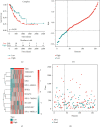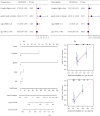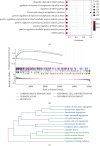A Novel Ferroptosis-Related Gene Signature to Predict Prognosis of Esophageal Carcinoma
- PMID: 35813863
- PMCID: PMC9270146
- DOI: 10.1155/2022/7485435
A Novel Ferroptosis-Related Gene Signature to Predict Prognosis of Esophageal Carcinoma
Abstract
Objective: This study aimed to develop a novel ferroptosis-related gene-based prognostic signature for esophageal carcinoma (ESCA).
Methods: The TCGA-ESCA gene expression profiles and corresponding clinical data were downloaded from the TCGA database. Ferroptosis-related genes were identified from the literature and public databases, which were intersected with the differentially expressed genes between ESCA and normal samples. After univariate Cox regression and random forest analyses, several ferroptosis-related feature genes were identified and used to construct a prognostic signature. Then, the prognostic value of the complex value and the correlation of the complex value with immune cell infiltration were analyzed. Moreover, function analysis, mutation analysis, and molecular docking on the ferroptosis-related feature genes were performed.
Results: Based on the TCGA dataset and ferroptosis pathway genes, 1929 ferroptosis-related genes were preliminarily selected. Following univariate Cox regression analysis and survival analysis, 14 genes were obtained. Then, random forest analysis identified 10 ferroptosis key genes. These 10 genes were used to construct a prognostic complex value. It was found that low complex value indicated better prognosis compared with high complex value. In different ESCA datasets, there were similar differences in the proportion of immune cell distribution between the high and low complex value groups. Furthermore, TNKS1BP1, AC019100.7, KRI1, BCAP31, and RP11-408E5.5 were significantly correlated with ESCA tumor location, lymph node metastasis, and age of patients. KRI1 had the highest mutation frequency. BCAP31 had the strongest binding ability with small molecules DB12830, DB05812, and DB07307.
Conclusion: We constructed a novel ferroptosis-related gene signature, which has the potential to predict patient survival and tumor-infiltrating immune cells of ESCA.
Copyright © 2022 Jian Wang et al.
Conflict of interest statement
The authors declare that they have no conflicts of interest.
Figures









Similar articles
-
Identification of ferroptosis genes in immune infiltration and prognosis in thyroid papillary carcinoma using network analysis.BMC Genomics. 2021 Jul 27;22(1):576. doi: 10.1186/s12864-021-07895-6. BMC Genomics. 2021. PMID: 34315405 Free PMC article.
-
Identification and validation of necroptosis-related prognostic gene signature and tumor immune microenvironment infiltration characterization in esophageal carcinoma.BMC Gastroenterol. 2022 Jul 15;22(1):344. doi: 10.1186/s12876-022-02423-6. BMC Gastroenterol. 2022. PMID: 35840882 Free PMC article.
-
Integrated analysis of ferroptosis and stemness based on single-cell and bulk RNA-sequencing data provide insights into the prognosis and treatment of esophageal carcinoma.Gene. 2024 Nov 15;927:148701. doi: 10.1016/j.gene.2024.148701. Epub 2024 Jun 15. Gene. 2024. PMID: 38885819
-
Construction and External Validation of a Ferroptosis-Related Gene Signature of Predictive Value for the Overall Survival in Bladder Cancer.Front Mol Biosci. 2021 May 21;8:675651. doi: 10.3389/fmolb.2021.675651. eCollection 2021. Front Mol Biosci. 2021. PMID: 34095228 Free PMC article.
-
A novel mitochondria-related gene signature in esophageal carcinoma: prognostic, immune, and therapeutic features.Funct Integr Genomics. 2023 Mar 29;23(2):109. doi: 10.1007/s10142-023-01030-2. Funct Integr Genomics. 2023. PMID: 36991225
Cited by
-
Mutant kri1l causes abnormal retinal development via cell cycle arrest and apoptosis induction.Cell Death Discov. 2024 May 24;10(1):251. doi: 10.1038/s41420-024-02022-2. Cell Death Discov. 2024. PMID: 38789412 Free PMC article.
-
Biomarkers of lymph node metastasis in esophageal cancer.Front Immunol. 2024 Sep 27;15:1457612. doi: 10.3389/fimmu.2024.1457612. eCollection 2024. Front Immunol. 2024. PMID: 39399490 Free PMC article. Review.
References
LinkOut - more resources
Full Text Sources
Miscellaneous

